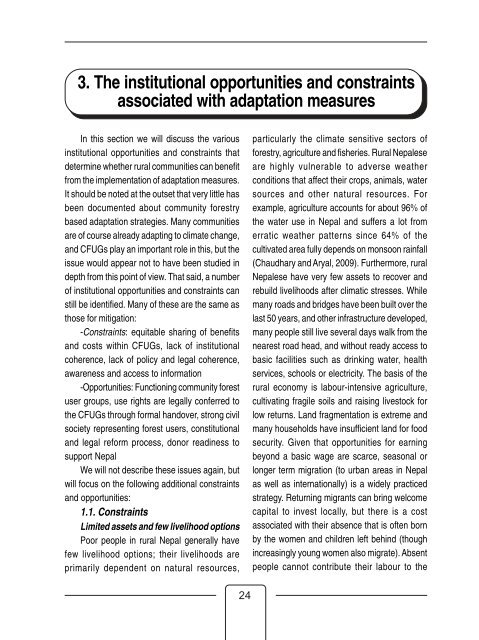Climate Change Mitigation and Adaptation
Climate Change Mitigation and Adaptation
Climate Change Mitigation and Adaptation
Create successful ePaper yourself
Turn your PDF publications into a flip-book with our unique Google optimized e-Paper software.
3. The institutional opportunities <strong>and</strong> constraints<br />
associated with adaptation measures<br />
In this section we will discuss the various<br />
institutional opportunities <strong>and</strong> constraints that<br />
determine whether rural communities can benefit<br />
from the implementation of adaptation measures.<br />
It should be noted at the outset that very little has<br />
been documented about community forestry<br />
based adaptation strategies. Many communities<br />
are of course already adapting to climate change,<br />
<strong>and</strong> CFUGs play an important role in this, but the<br />
issue would appear not to have been studied in<br />
depth from this point of view. That said, a number<br />
of institutional opportunities <strong>and</strong> constraints can<br />
still be identified. Many of these are the same as<br />
those for mitigation:<br />
-Constraints: equitable sharing of benefits<br />
<strong>and</strong> costs within CFUGs, lack of institutional<br />
coherence, lack of policy <strong>and</strong> legal coherence,<br />
awareness <strong>and</strong> access to information<br />
-Opportunities: Functioning community forest<br />
user groups, use rights are legally conferred to<br />
the CFUGs through formal h<strong>and</strong>over, strong civil<br />
society representing forest users, constitutional<br />
<strong>and</strong> legal reform process, donor readiness to<br />
support Nepal<br />
We will not describe these issues again, but<br />
will focus on the following additional constraints<br />
<strong>and</strong> opportunities:<br />
1.1. Constraints<br />
Limited assets <strong>and</strong> few livelihood options<br />
Poor people in rural Nepal generally have<br />
few livelihood options; their livelihoods are<br />
primarily dependent on natural resources,<br />
particularly the climate sensitive sectors of<br />
forestry, agriculture <strong>and</strong> fisheries. Rural Nepalese<br />
are highly vulnerable to adverse weather<br />
conditions that affect their crops, animals, water<br />
sources <strong>and</strong> other natural resources. For<br />
example, agriculture accounts for about 96% of<br />
the water use in Nepal <strong>and</strong> suffers a lot from<br />
erratic weather patterns since 64% of the<br />
cultivated area fully depends on monsoon rainfall<br />
(Chaudhary <strong>and</strong> Aryal, 2009). Furthermore, rural<br />
Nepalese have very few assets to recover <strong>and</strong><br />
rebuild livelihoods after climatic stresses. While<br />
many roads <strong>and</strong> bridges have been built over the<br />
last 50 years, <strong>and</strong> other infrastructure developed,<br />
many people still live several days walk from the<br />
nearest road head, <strong>and</strong> without ready access to<br />
basic facilities such as drinking water, health<br />
services, schools or electricity. The basis of the<br />
rural economy is labour-intensive agriculture,<br />
cultivating fragile soils <strong>and</strong> raising livestock for<br />
low returns. L<strong>and</strong> fragmentation is extreme <strong>and</strong><br />
many households have insufficient l<strong>and</strong> for food<br />
security. Given that opportunities for earning<br />
beyond a basic wage are scarce, seasonal or<br />
longer term migration (to urban areas in Nepal<br />
as well as internationally) is a widely practiced<br />
strategy. Returning migrants can bring welcome<br />
capital to invest locally, but there is a cost<br />
associated with their absence that is often born<br />
by the women <strong>and</strong> children left behind (though<br />
increasingly young women also migrate). Absent<br />
people cannot contribute their labour to the<br />
24

















